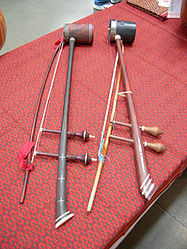 Two tro fiddles with cylinder-shaped resonance chambers. Bows are laid with the instruments, passing between fiddle strings and not separated without taking the strings loose. | |
| Classification | |
|---|---|
| Hornbostel–Sachs classification |
|
| Related instruments | |
|
The tro ou is similar to the: The tro saus are similar to the: | |
The tro (Khmer: ទ្រ) is Cambodia's traditional spike fiddle, a bowed string instrument that is held and played vertically.[1] Spike fiddles have a handle that passes through the resonator, often forming a spike, on the bottom side where it emerges. The family is similar or distantly related to the Chinese erhu or huqin.[1] The instruments have a soundbox at the bottom of the stick, covered with leather or snake skin. Strings run from pegs at the top of the stick and secured at the bottom, running across the soundbox. The larger the soundbox, the lower the pitch range. Instruments in this family include the two-stringed tro ou, tro sau thom, tro sau toch and tro che, as well as the three-stringed tro Khmer spike fiddle.[1] The two-stringed tros are tuned in a fifth, while the three-stringed tro Khmer is tuned in fourths.[1] The tros, with the exception of the tro Khmer, are strung so that the bowstring is permanently placed between the two stings. When the musician plays, the placement of the bow causes the strings to be played at once, one from below and one from above. In contrast, western fiddles (such as the violin) are played with the bow pushing on each string from the outside, as is also the case with the tro khmer.